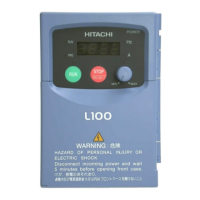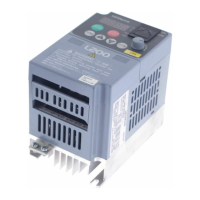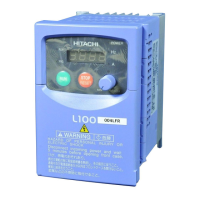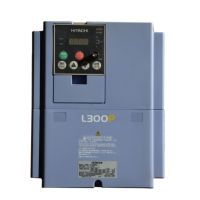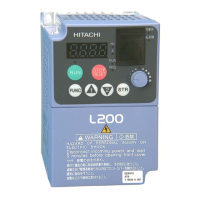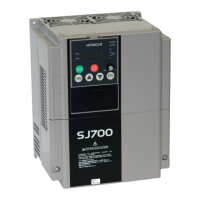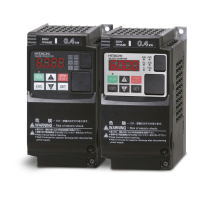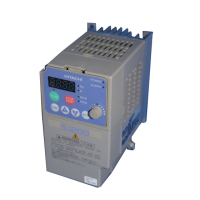7-2
7.2 Common specifications
*1) Output frequency range will depend on the motor control method and the motor used. Consult the motor manufacturer for the maximum
allowable frequency of the motor when operating beyond 60Hz.
*2) In case of the control mode is changed and the motor constant is not set appropriately, the desired starting torque cannot be obtained and also
exists the possibility of tripping.
*3) Regarding the speed range regulation of motor, the variable range depends on the client system and the environment in which the motor is used.
Please contact Hitachi inverter distributers for more information.
*4) Both the input power and output power are reference values, which are not appropriate for use in calculation of efficiency values, etc. To obtain an
accurate value, use an external device.
*5) If the IGBT error [E030] occurs by the protective function, it may have happened by the short-circuit protection, but also can occur if the IGBT is
damaged. Depending on the operation status of the inverter, instead of the IGBT error, the overcurrent error [E001] may also occur.
*6) At factory setting, the maximum output frequency for analog input signal Ai1/Ai2 is adjusted to 9.8V for voltage input and 19.6mA for current input.
In order to adjust the specification use analog start/end function.
Output frequency range *1)
For the highest frequency, digital±0.01%, analog±0.2% (25±10℃)
Digital: 0.01Hz
Analog: Max. frequency/4000
(Ai1 terminal/Ai2 terminal:12bit/0~+10V or 0~+20mA, Ai3 terminal 12bit/-10~+10V)
V/f control (constant torque/reduced torque/ free / automatic boost control )
V/f with encoder( constant torque/reduced torque/ free / automatic boost control )
Cascade type sensorless vector control, Vector control with encoder
synchronous startup for smart sensorless vector control
±0.5%(sensorless vector control)
Acceleration/deceleration time
0.00~3600.00s (Linear, S-curve, U-curve, Inverted-U-curve, EL-S-curve)
Output frequency, Output current, Output torque, trip history, input/output terminal status, input/output terminal function,
input/output power *4), PN voltage, etc, the rest is described in the chapter 4.
DC braking after the start, matching frequency after the start, active frequency matching start, Low-voltage start, retry restart.
After free run stop, deceleration stop, DC braking or external DC braking operation (Braking force, time, adjustment of operation
speed)
Stall prevention function
Overload limit function, overcurrent supression, overvoltage suppresion function
Overcurrent error, Overload error, Brake resistor overload,Overvoltage error, Memory error, Undervoltage error, Current detector
error, CPU error, External trip error, USP error, Ground error, Supply overvoltage error, Power loss error, Temperature detector
error, Cooling-fan rotation speed decrease temperature error, Temperature error, Input open-phase error, IGBT error, Output
open-phase error, Thermistor error, brake error, low-speed range overload error, Controller overload error, RS485communication
error, RTC error, EzSQ related error, option related error, functional safety related error, position control range error, speed
deviation error, position deviation error, overspeed error, contactor error, PID start error.
V/f free setting (7 points), upper and lower speed limit, speed jump, curve acceleration and deceleration, manual torque boost,
energy-saven operation, analog output adjustment, minimun speed, carrier frequency adjustment, motor electronic thermal
function(free is possible), inverter thermal function, external start-end(speed and rate), frequency input selection, trip retry, restart
stop, various signal output, inilization setting, PID control, auto-decel at shut-off, brake control function, commercial power
switching function, auto-tuning (on/offline), etc. the rest is described in the chapter 4.
UP, DOWN keys according to the set parameter.
Ai1/Ai2 terminal (for voltage input)
0~10Vdc set by the voltage input (Input impedance:10kΩ)
Ai1/Ai2 terminal (for current input)
0~20mA set by the current input (Input impedance:100Ω)
-10~+10Vdc set by the voltage input (Input impedance:10kΩ)
16multi-speed(With the use of the intelligent input terminal)
RS485 serial communication (Protocol: Modbus-RTU)
By RUN/Stop key (With the set parameter, forward/reverse can be switched)
Forward (FW)/Reverse(RV)(When input terminal functions are allocated)
3-wire input allowed(When input terminal functions are allocated)
Set by RS485 communication (Maximum: 115.2kbps)
Intelligent input terminals
11 terminals (A or B terminal accept a pulse train)
FW(Forward rotation)/RV(Reverse rotation), CF1 to CF4(Multi-speed 1 to 4), SF1 to SF7(Multi-speed bit 1 to 7), ADD(Trigger for
frequency addition), SCHG(Main/Sub speed reference change), STA(3-wire start)/STP(3-wire stop)/ F/R( 3-wire Forward/reverse),
AHD(Analog command holding), FUP(Remote speed up)/FDN(Remote speed down)/UDC(Remote speed data clearing), F-OP(Force
operation), SET(2nd-motor), RS(Reset), JG(Jogging), DB(External Dynamic brake), 2CH(2-stage Accel/Decel), FRS(Free-run stop),
EXT(External fault), USP(Unattended start protection), CS(Commercial power supply change), SFT(Software lock), BOK(Braking
confirmation), OLR(Overload restriction selection), KHC(Accumulated input power clearance), OKHC(Accumulated output power
clearance), PID to PID4(PID1 to PID4 disable), PIDC to PIDC4(PID1 to PID4 integration reset), SVC1 to 4(PID1 multistage target value
1 to 4), PRO(PID gain change), PIO1/2(PID output switching 1/2), SLEP(SLEEP condition activation)/WAKE(WAKE condition
activation), TL(Torque limit enable), TRQ1/2(Torque limit selection1/2), PPI(P/PI mode selecton), CAS(Control gain change),
SON(Servo-ON), FOC(Forcing), ATR(Permission of torque control), TBS(Torque bias enable), ORT(Home search function), LAC(LAD
cancellation), PCLR(Clearance of position deviation), STAT(pulse train position reference input enable), PUP(Position bias (ADD)),
PDN(Position bias (SUB)), CP1 to CP4(Multistage position 1 to 4), ORL(Limit signal of Homing ), ORG(Start signal of Homing),
FOT(Forward over travel), ROT(Reserve over travel), SPD(Speed/position switching), PSET(Position data presetting), Mi1~
11(General-purpose input 1 to 11), PCC(Pulse counter clearing), ECOM(EzCOM activation), PRG(Program RUN), HLD(accel/decel
disable), REN(RUN enable), DISP(Display lock), PLA(Pulse count A), PLB(Pulse count B), EMF(Emergency-force drive activation),
COK(Contactor check signal), DTR(Data trace start), PLZ(Pulse train input Z), TCH( Teach-in signal)
P+/P-: DC24V input(Input allowable voltage: 24V±10%)
Thermistor input terminal
1 terminal (PTC/NTC resistor allowed)
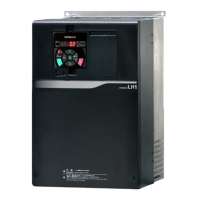
